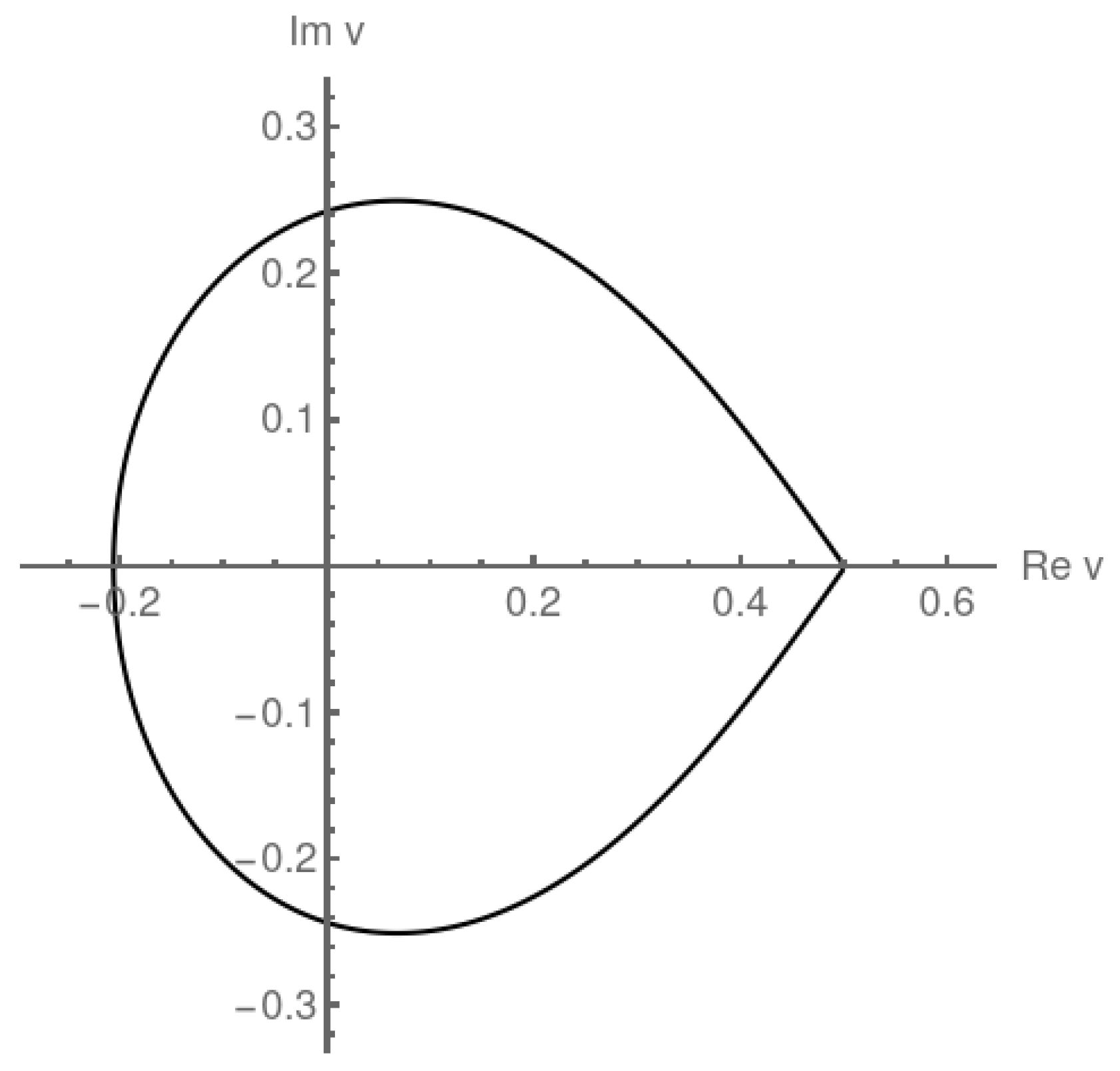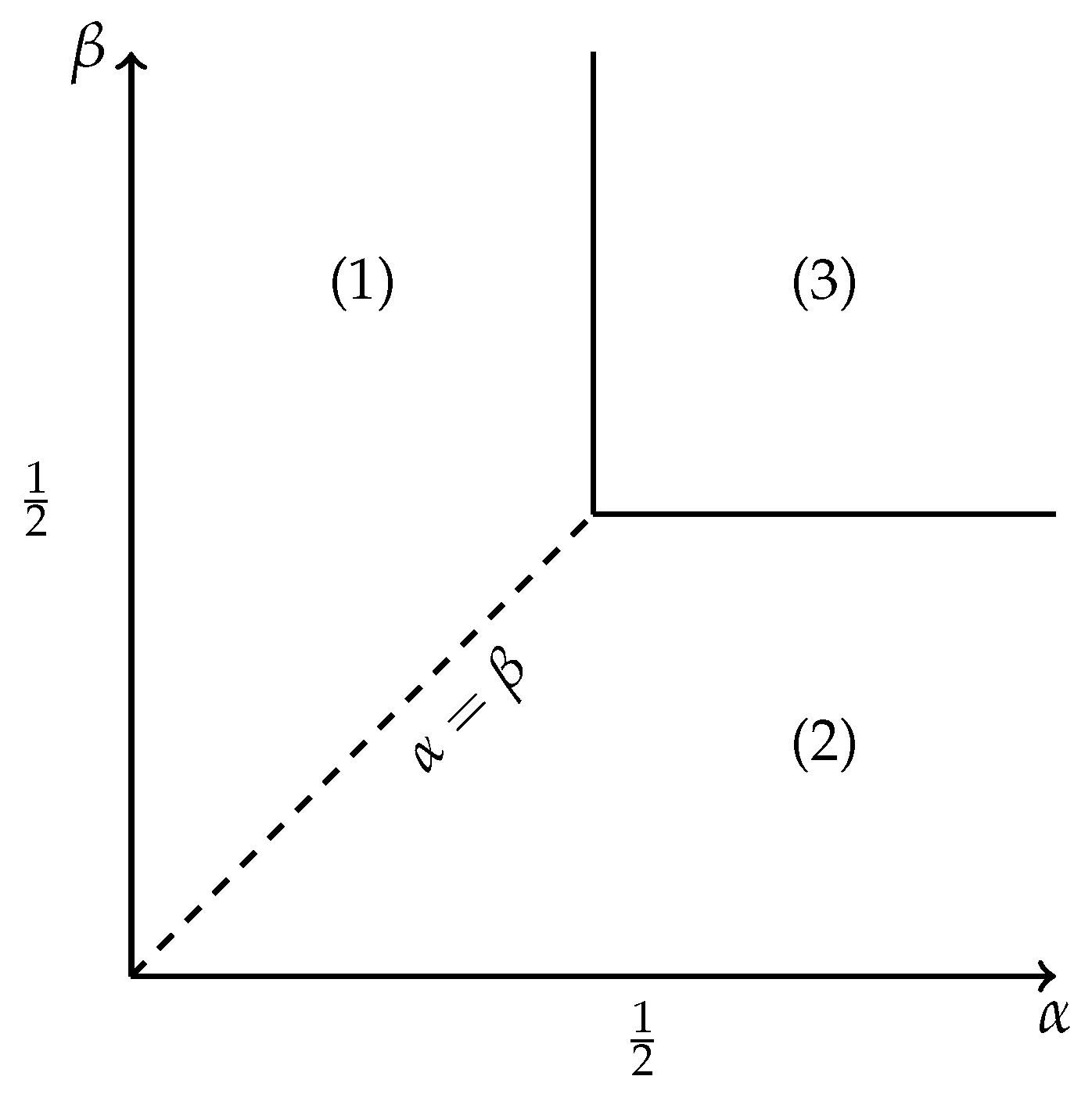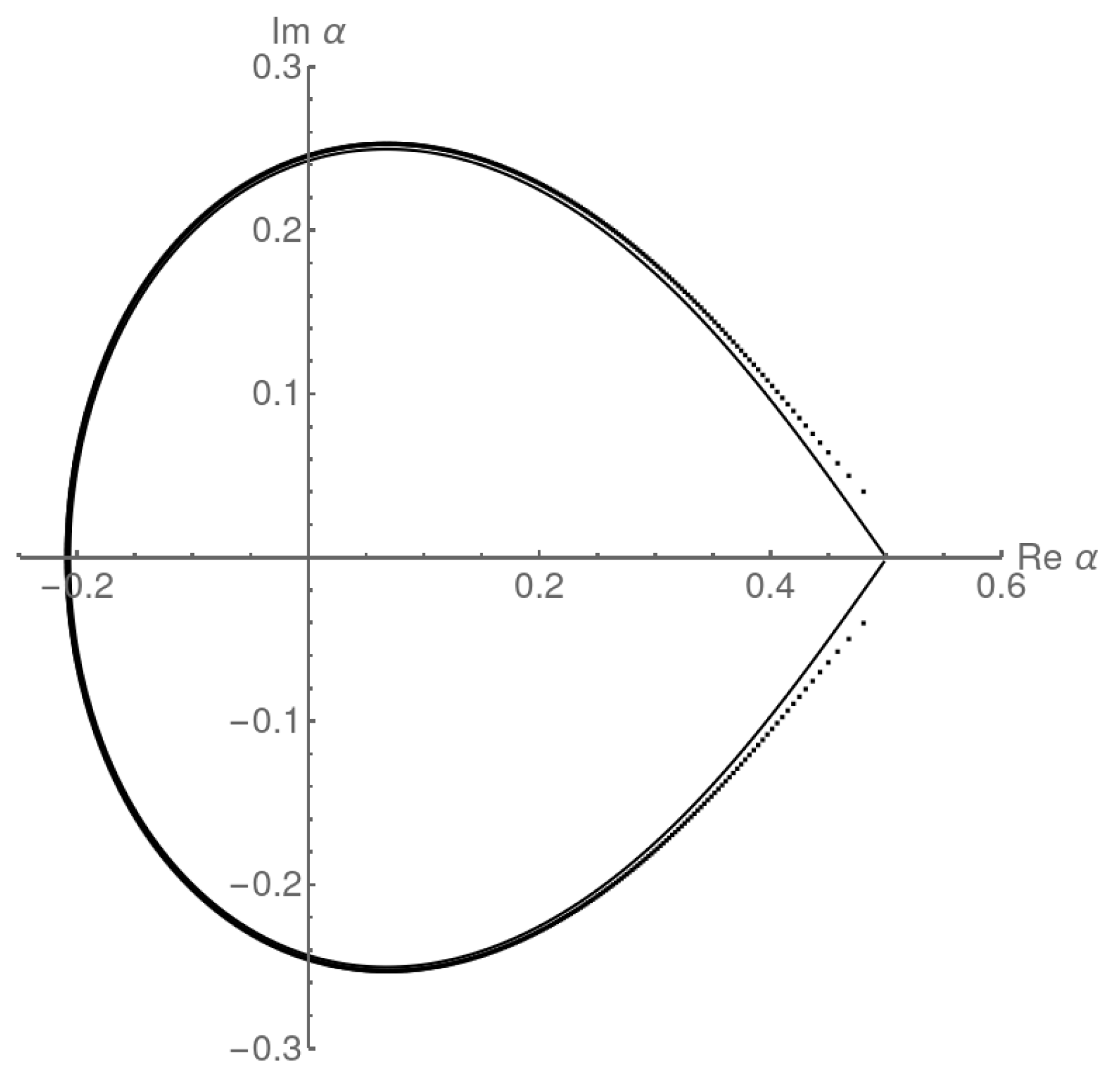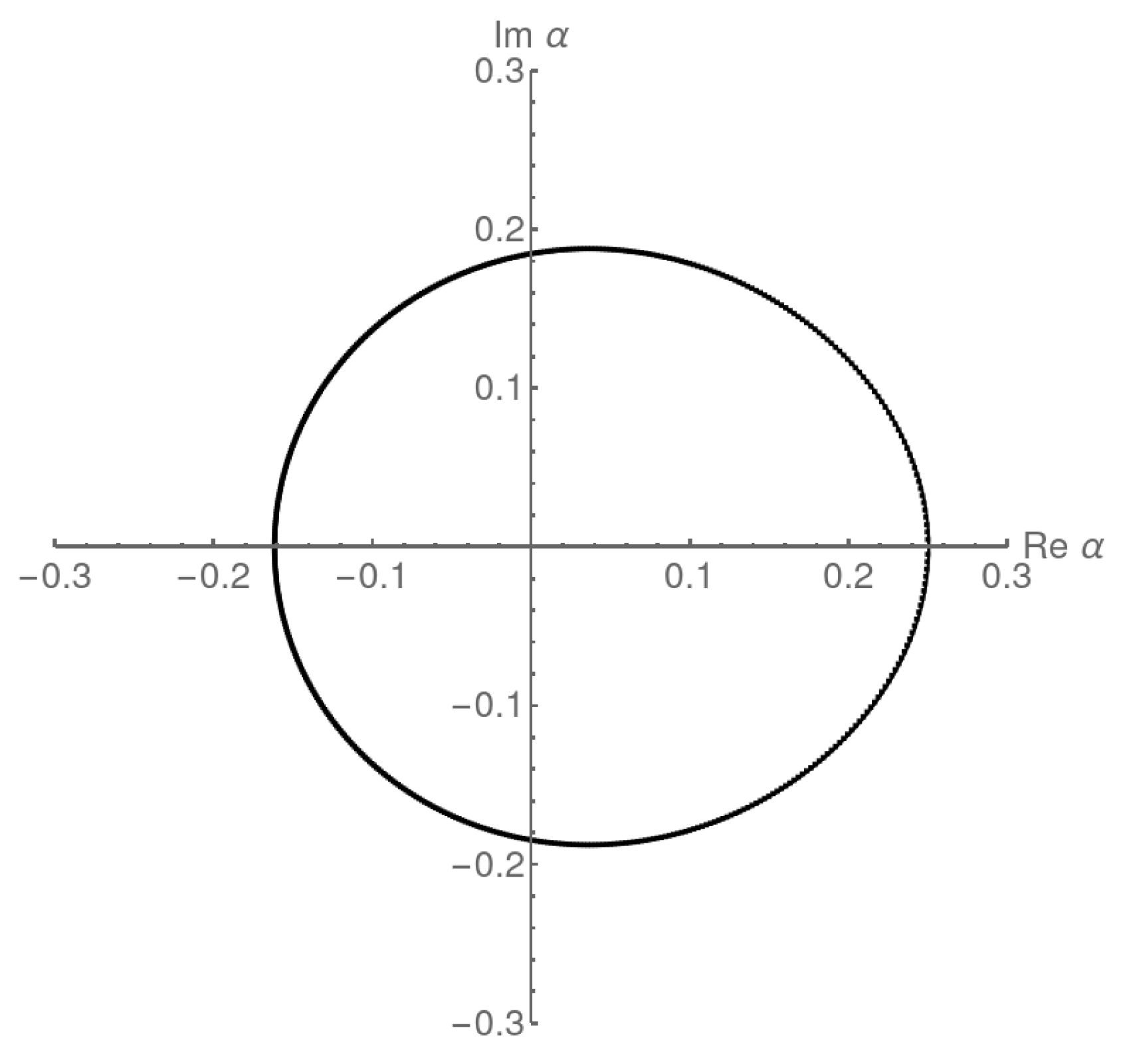Partition Function Zeros of Paths and Normalization Zeros of ASEPS
Abstract
:1. Introduction
2. General Observations
- The location of ’s singularities determine A. Specifically, if the closest singularity to the origin along the real axis is , then
- The nature of the singularities determine .
- Additionally, it is often useful to rescale so that the generating functions are singular at 1 using
- Supercritical . As z is increased from 0 there will be some value strictly less than such that . In this case, the singularity type is that of the external function g.
- Subcritical . In this case, the singularity of the composition is driven by that of the internal function f.
- Critical . Here, there is a confluence of the two singularities.
3. Random Allocation Model: Canonical Ensemble
4. Random Allocation Model: Other Ensembles
5. Binomial Weights and Lattice Paths
6. ASEPs and Lattice Paths
| Move | Rate |
| Particle inserted onto the left boundary site (if empty) | |
| Particle removed from the right boundary site (if occupied) | |
| Particle hops by one site to (an empty site on) its right | 1 |
7. Discussion
Author Contributions
Funding
Institutional Review Board Statement
Data Availability Statement
Acknowledgments
Conflicts of Interest
References
- Yang, C.N.; Lee, T.D. Statistical Theory of Equations of State and Phase Transitions. I. Theory of Condensation. Phys. Rev. 1952, 87, 404–409. [Google Scholar] [CrossRef]
- Lee, T.D.; Yang, C.N. Statistical Theory of Equations of State and Phase Transitions. II. Lattice Gas and Ising Model. Phys. Rev. 1952, 87, 410–419. [Google Scholar] [CrossRef]
- Bena, I.; Droz, M.; Lipowski, A. Statistical Mechanics of Equilibrium and Nonequilibrium Phase Transitions. Int. J. Mod. Phys. B 2005, 19, 4269–4329. [Google Scholar] [CrossRef]
- Blythe, R.A.; Evans, M.R. The Lee–Yang theory of equilibrium and nonequilibrium phase transitions. Braz. J. Phys. 2003, 33, 464–475. [Google Scholar] [CrossRef]
- Abe, R. On the Zeros of the Partition Function for the Ising Model. Prog. Theor. Phys. 1967, 37, 1070–1072. [Google Scholar] [CrossRef]
- Suzuki, M. A Theory on the Critical Behaviour of Ferromagnets. Prog. Theor. Phys. 1967, 38, 289–291. [Google Scholar] [CrossRef]
- Fisher, M.E. Lectures in Theoretical Physics; Brittin, W.E., Ed.; Gordon and Breach: New York, NY, USA, 1968; Volume VII, pp. 1–46. [Google Scholar]
- Janke, W.; Johnston, D.A.; Kenna, R. Properties of Higher-Order Phase Transitions. Nucl. Phys. B 2006, 736, 319–338. [Google Scholar] [CrossRef]
- Biskup, M.; Borgs, C.; Chayes, J.T.; Kleinwaks, L.J.; Kotecký, R. Partition Function Zeros at First-Order Phase Transitions: A General Analysis. Commun. Math. Phys. 2004, 251, 79–131. [Google Scholar] [CrossRef]
- Biskup, M.; Borgs, C.; Chayes, J.T.; Kleinwaks, L.J.; Kotecký, R. General Theory of Lee–Yang Zeros in Models with First-Order Phase Transitions. Phys. Rev. Lett. 2000, 84, 4794–4797. [Google Scholar] [CrossRef]
- Shlosman, S.B. Unusual Analytic Properties of Some Lattice Models: Complement of Lee–Yang Theory. Teor. Mat. Fiz. 1986, 69, 273–278. [Google Scholar] [CrossRef]
- Matveev, V.; Shrock, R. Complex-Temperature Singularities of the Susceptibility in the d = 2 Ising Model. I. Square Lattice. J. Phys. A 1995, 28, 1557–1573. [Google Scholar] [CrossRef]
- Katsura, S.; Ohminami, M. Distribution of zeros of the partition function for the one dimensional Ising models. J. Phys. A 1972, 5, 95–105. [Google Scholar] [CrossRef]
- Glumac, Z.; Uzelac, K. The partition function zeros in the one-dimensional q-state Potts model. J. Phys. A 1994, 27, 7709–7720. [Google Scholar] [CrossRef]
- Ghulghazaryan, R.G.; Ananikian, N.S. Partition function zeros of the one-dimensional Potts model: The recursive method. J. Phys. A 2003, 36, 6297–6305. [Google Scholar] [CrossRef]
- Krasnytska, M.; Berche, B.; Holovatch, Y.; Kenna, R. Partition function zeros for the Ising model on complete graphs and on annealed scale-free networks. J. Phys. A 2016, 49, 135001. [Google Scholar] [CrossRef]
- Itzykson, C.; Pearson, R.; Zuber, J.B. Distribution of Zeros in Ising and Gauge Models. Nucl. Phys. B 1983, 220, 415–433. [Google Scholar] [CrossRef]
- Baake, M.; Grimm, U.; Pisani, C. Partition Function Zeros for Aperiodic Systems. J. Stat. Phys. 1995, 78, 285–297. [Google Scholar] [CrossRef]
- Repetowicz, P.; Grimm, U.; Schreiber, M. Planar quasiperiodic Ising models. Mater. Sci. Eng. A 2000, 294–296, 638–641. [Google Scholar] [CrossRef]
- Derrida, B. The zeroes of the partition function of the random energy model. Physica A 1991, 177, 31–37. [Google Scholar] [CrossRef]
- Staudacher, M. The Yang-Lee edge singularity on a dynamical planar random surface. Nucl. Phys. B 1990, 336, 349–362. [Google Scholar] [CrossRef]
- Janke, W.; Johnston, D.A.; Stathakopoulos, M. Fat Fisher Zeroes. Nucl. Phys. B 2001, 614, 494–514. [Google Scholar] [CrossRef]
- Burda, Z.; Johnston, D.A.; Kieburg, M. Yang-Lee Zeros for Real-Space Condensation. Phys. Rev. E 2025, 111, L012101. [Google Scholar] [CrossRef]
- Flajolet, P.; Sedgewick, R. Analytic Combinatorics; Cambridge University Press: Cambridge, UK, 2009. [Google Scholar]
- Godrèche, C. Condensation for random variables conditioned by the value of their sum. J. Stat. Mech. 2019, 063207. [Google Scholar] [CrossRef]
- Godrèche, C. Condensation and Extremes for a Fluctuating Number of Independent Random Variables. J. Stat. Phys. 2021, 182, 13. [Google Scholar] [CrossRef]
- Godrèche, C.; Luck, J.M. Nonequilibrium dynamics of a simple stochastic model. J. Phys. A 1997, 30, 6245–6264. [Google Scholar] [CrossRef]
- Corberi, F.; Sarracino, A. Probability Distributions with Singularities. Entropy 2019, 21, 312. [Google Scholar] [CrossRef] [PubMed]
- Blythe, R.A.; Evans, M.R. Lee–Yang Zeros and Phase Transitions in Nonequilibrium Steady States. Phys. Rev. Lett. 2002, 89, 080601. [Google Scholar] [CrossRef] [PubMed]
- Blythe, R.A.; Janke, W.; Johnston, D.A.; Kenna, R. The Grand-Canonical Asymmetric Exclusion Process and the One-Transit Walk. J. Stat. Mech. 2004, P06001. [Google Scholar] [CrossRef]
- Ritort, F. Glassiness in a Model without Energy Barriers. Phys. Rev. Lett. 1995, 75, 1190–1193. [Google Scholar] [CrossRef]
- Bialas, P.; Burda, Z.; Johnston, D. Condensation in the Backgammon Model. Nucl. Phys. B 1997, 493, 505–516. [Google Scholar] [CrossRef]
- Ehrenfest, P.; Ehrenfest, T. Über zwei bekannte Einwände gegen das Boltzmannsche H-Theorem. Phys. Zeit. 1907, 8, 311–314. [Google Scholar]
- Bialas, P.; Burda, Z. Phase Transition in Fluctuating Branched Geometry. Phys. Lett. B 1996, 384, 75–80. [Google Scholar] [CrossRef]
- Franz, S.; Ritort, F. Glassy Mean-Field Dynamics of the Backgammon Model. J. Stat. Phys. 1996, 85, 131–150. [Google Scholar] [CrossRef]
- Bialas, P.; Burda, Z.; Johnston, D. Phase Diagram of the Mean Field Model of Simplicial Gravity. Nucl. Phys. B 1999, 542, 413–424. [Google Scholar] [CrossRef]
- Bialas, P.; Burda, Z.; Johnston, D. Random Allocation Models in the Thermodynamic Limit. Phys. Rev. E 2023, 108, 064107. [Google Scholar] [CrossRef]
- Bialas, P.; Burda, Z.; Johnston, D. Rényi Entropy of Zeta Urns. Phys. Rev. E 2023, 108, 064108. [Google Scholar] [CrossRef]
- Bialas, P.; Burda, Z.; Johnston, D. Partition Function Zeros of Zeta-Urns. Condens. Matter Phys. 2024, 27, 33601. [Google Scholar] [CrossRef]
- Janse van Rensburg, E.J. The Statistical Mechanics of Interacting Walks, Polygons, Animals and Vesicles; Oxford University Press: Oxford, UK, 2000; pp. 98–104. [Google Scholar]
- Derrida, B.; Evans, M.R.; Hakim, V.; Pasquier, V. Exact Solution of a 1D Asymmetric Exclusion Model Using a Matrix Formulation. J. Phys. A Math. Gen. 1993, 26, 1493–1517. [Google Scholar] [CrossRef]
- Blythe, R.A.; Janke, W.; Johnston, D.A.; Kenna, R. Dyck Paths, Motzkin Paths and Traffic Jams. J. Stat. Mech. 2004, P10007. [Google Scholar] [CrossRef]
- Wood, A.J.; Blythe, R.A.; Evans, M.R. Combinatorial Mappings of Exclusion Processes. J. Phys. A Math. Theor. 2020, 53, 123001. [Google Scholar] [CrossRef]






Disclaimer/Publisher’s Note: The statements, opinions and data contained in all publications are solely those of the individual author(s) and contributor(s) and not of MDPI and/or the editor(s). MDPI and/or the editor(s) disclaim responsibility for any injury to people or property resulting from any ideas, methods, instructions or products referred to in the content. |
© 2025 by the authors. Licensee MDPI, Basel, Switzerland. This article is an open access article distributed under the terms and conditions of the Creative Commons Attribution (CC BY) license (https://creativecommons.org/licenses/by/4.0/).
Share and Cite
Burda, Z.; Johnston, D.A. Partition Function Zeros of Paths and Normalization Zeros of ASEPS. Entropy 2025, 27, 183. https://doi.org/10.3390/e27020183
Burda Z, Johnston DA. Partition Function Zeros of Paths and Normalization Zeros of ASEPS. Entropy. 2025; 27(2):183. https://doi.org/10.3390/e27020183
Chicago/Turabian StyleBurda, Zdzislaw, and Desmond A. Johnston. 2025. "Partition Function Zeros of Paths and Normalization Zeros of ASEPS" Entropy 27, no. 2: 183. https://doi.org/10.3390/e27020183
APA StyleBurda, Z., & Johnston, D. A. (2025). Partition Function Zeros of Paths and Normalization Zeros of ASEPS. Entropy, 27(2), 183. https://doi.org/10.3390/e27020183






